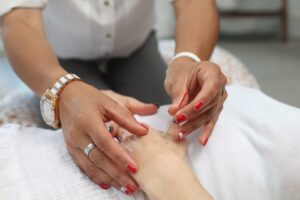Subscribe to the Newsletter
If you are interested in understanding how Traditional Chinese Medicine can improve your life sign up to my newsletter for the latest updates.

Aggravations after taking a homoeopathic remedy are usually welcomed by your homoeopath, if not you!
Aggravations are exacerbations of existing, ongoing or chronic symptoms, or the return of earlier symptoms during a process that leads from ill-health to better health.
What that means is that after taking a homoeopathic remedy, you feel worse … for a while.
For example, for a while …

Well, ‘thanks a bundle’ you say! ‘If that’s what happens after taking a homoeopathic remedy, I shan’t bother!’
Most of those ‘old’ conditions were ‘fixed’ by treatments that were specific to the problem: the physical ‘adjustment to your back, the drug that cleared your insomnia, the medication that stopped your indigestion, the steroid injection that cleared the joint-pain.
If, as homoeopathic philosophy and experience suggest, at almost all times your body is doing the best it knows how, i.e. its very best attempt at ‘containing’ a problem or ‘isolating’ it from penetrating further, (if it cannot actually ‘clear’ it out), then by suppressing that symptom you are forcing your body backwards onto it second- or third-best option.
That lesser option nearly always mean lowered vitality and increased susceptibility to further or worse disease.
If you can get your head round that, think what might happen if your body receives the message or plan it lacked in the first place.
Suddenly it knows how to get better!
BUT!!! There’s a problem – somebody else tinkered with the system beforehand,. and the system it’s trying to mend is different from the system it’s got. It was expecting there to be back pain, insomnia, digestive problems and a sore joint. Where are they?
What to do?
When you were smaller, did you ever get written directions from your mother telling you where to find her. Perhaps she said:
“Starting from the bus stop where you get off the bus, cross the road then turn left. Walk until you reach the second turning to the right. Take that turning and I’ll be in the third house on the left.”

Clear enough?
But … just suppose you missed the bit about ‘crossing the road’! You’d end up in the diametrically opposite direction to where your mother is. To find her, you’d retrace your steps to the bus stop, then cross the road as instructed and find her a few minutes later.
Your body, having received the correct homoeopathic remedy, retraces its steps back to where it started. From there it knows how to get home – the remedy is the map.
But to get back it may have to re-create some or all of the conditions that had been suppressed. Only then does it recognise the territory and know – from the map – how to move towards health.
The correct, or homoeopathic, remedy is the one that would have been able to create in someone like you, before you got ill, similar conditions to those you want help for.
If the remedy you receive is homoeopathic, your body can use it as stimulus to re-create then solve the problems for which you received all those different treatments.
The aggravation you get comes about as your body energetically goes about its business.
Short answer? Don’t know!
Longer answer? It depends usually on a selection of the following:
Usually aggravations last between a few minutes and a few weeks.
Sometimes a homoeopath will intervene to modify them, but it’s usually best to let your body find its own way through them.
Usually, strong aggravations suggest a strong underlying vital force.
An aggravation is an exacerbation of your own existing, ongoing or previous symptoms during a process that leads to better health.
A proving is a test carried out when a new substance is entered into the homoeopathic pharmacopoeia. The symptoms of the proving are those experienced and reported by or observed in healthy individuals who took the new substance, during the minutes, hours, days and months, even years, after taking it.
Eventually these symptoms are arranged in a way that homoeopaths can recognise and use for patients who have similar conditions to those experienced by the provers.
Read more about provings here.
So a proving is done on healthy people. If after taking a remedy you experience symptoms belonging to the remedy and not those previously part of your own symptom picture, you could be said to be proving part of the remedy.
Don’t worry, these additional symptoms disappear quite quickly, just as they did in the original provers.
NB There are a few people who prove everything or, at least, many remedies they take! They are very sensitive, and usually know this. It doesn’t stop them getting better, (after all, their peculiar sensitivity is part of their picture) but it can make it harder for the homoeopath because the aggravation symptoms may be less clear-cut.
Well … so as not to get too technically nerdy … I’d say, find a homoeopath who does, because a homoeopath who doesn’t believe in aggravations is probably quite good at suppressing symptoms, to the long-term detriment of his patients’ (…? your ?…) health.
So yes, you can suppress symptoms with homoeopathy.
No. Lots of people get better without having, or at least without noticing, any aggravation.
Usually this happens when there is no long-term deep history of chronic disease(s) for which they’ve been treated over the years.
The more ‘suppressive’ treatments they’ve had, the more likely they will experience at least some aggravation.
Classical homoeopaths feel reassured in their choice of a remedy for a patient if there is a noticeable aggravation of existing or previous symptoms. It makes it more likely that the eventual outcome of treatment will be successful.
Certainly not! Usually they occur after the remedy (which may not have been the first remedy taken), that is closest to the constitutional picture of the patient.
‘Constitutional …?’ What’s that?
Well … this takes a bit of explaining, so it’s going on another page. Keep checking! Meantime, put ‘constitution’ into our search box, because it is mentioned on other pages, such as:
Practising homoeopathy the classical way, which I try to do, is not easy. It requires

So far, all that is needed is a lot of work, application, reading (there are a LOT of books to read!), learning and watching others – over a period of years, culminating in examinations and some kind of diploma.
Then you need:
My knowledge of Chinese medicine enormously benefits my practice of homoeopathy. It means I can often explain symptoms in a way that makes sense to the patient, using the Chinese medical theory, or acupuncture-meridian theory.
But I very seldom use them together. Doing so can be very confusing.
However, I do have patients who come for acupuncture or Chinese medicine and are already taking homoeopathic remedies prescribed by someone else, or self-prescribed. They are not usually easy to treat.
I am a member of the Scottish Association of Professional Homoeopaths.

Stay in Touch!
No spam, only notifications about new articles and updates.

Book a Video consultation if you want to know more about your symptoms

This Introductory Chinese medicine course introduces you to the amazing thinking behind this ancient medicine, now increasingly in demand.

The Scottish College for Chinese medicine provides introductory courses for all, explaining Chinese medicine and its cultural background.

Master Tung’s acupuncture is a hidden treasure, lost to China but recovered in Taiwan from where it spread round the world.

Knee pain has five main causes. It’s certainly worth trying acupuncture before you resort to surgery!
Subscribe to the Newsletter
If you are interested in understanding how Traditional Chinese Medicine can improve your life sign up to my newsletter for the latest updates.
Subscribe to the Newsletter
If you are interested in understanding how Traditional Chinese Medicine can improve your life sign up to my newsletter for the latest updates.